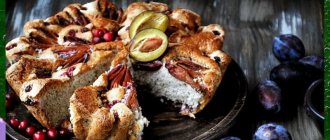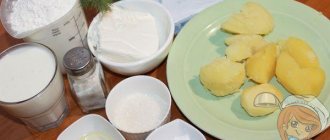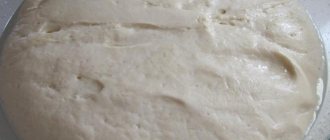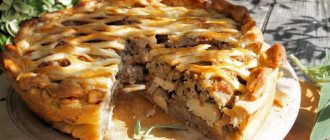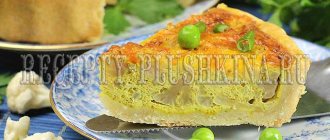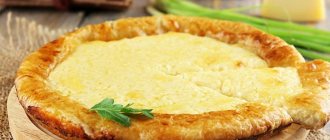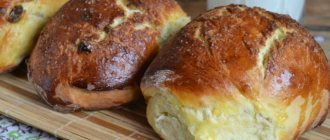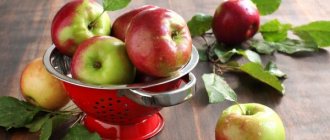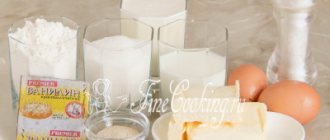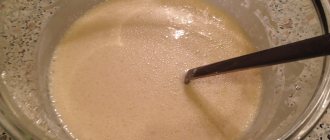In the cold autumn, more than ever, you want to plunge into the warmth and comfort of home in order to escape the rain and cold. Therefore, gathering with your family at a common table with nice conversations and hot tea is a mandatory ritual. And the recipe for Ossetian cheese pie will come in very handy here, because this particular Caucasian dish can fill you with a good mood. So, how to cook Ossetian cheese pie?
Ossetian pies are symbols of the Sun in their distant homeland. Having a golden color and a round shape, these flatbreads truly become a little sun on the table. And if you bake it correctly, it will have an amazing delicate texture and spread a wonderful aroma throughout the entire apartment.
Previously, you could only try Ossetian cheese pies in their homeland. But now there are many detailed recipes according to which residents of other countries can create similar “home suns” on their own.
Types of Ossetian pies
These flatbreads are filled by Ossetians with a variety of fillings. They say that these fillings were born according to the scheme: “We cook with what is in the refrigerator.” But today it is a whole layer of culture, and there is a whole classification of these Asian dishes: Ossetian pie with cheese and herbs, with potatoes and cheese, cabbage, pumpkin, various types of meat, etc.
The most classic is the Ossetian pie with cheese and herbs, which is called ualibakh in the local dialect. But today we will look at an equally popular and tasty, but more filling version of the dish called kartofdzhin - an Ossetian pie with potatoes and cheese.
Recipe for Adyghe pie with potatoes and cheese. Calorie, chemical composition and nutritional value.
Nutritional value and chemical composition of “Adyghe pie with potatoes and cheese.”
The table shows the nutritional content (calories, proteins, fats, carbohydrates, vitamins and minerals) per 100 grams of edible portion.
| Nutrient | Quantity | Norm** | % of the norm in 100 g | % of the norm in 100 kcal | 100% normal |
| Calorie content | 170.8 kcal | 1684 kcal | 10.1% | 5.9% | 986 g |
| Squirrels | 6 g | 76 g | 7.9% | 4.6% | 1267 g |
| Fats | 2.9 g | 56 g | 5.2% | 3% | 1931 |
| Carbohydrates | 29.9 g | 219 g | 13.7% | 8% | 732 g |
| Organic acids | 0.4 g | ~ | |||
| Alimentary fiber | 1.7 g | 20 g | 8.5% | 5% | 1176 g |
| Water | 64 g | 2273 g | 2.8% | 1.6% | 3552 g |
| Ash | 1.268 g | ~ | |||
| Vitamins | |||||
| Vitamin A, RE | 11.8 mcg | 900 mcg | 1.3% | 0.8% | 7627 g |
| Retinol | 0.008 mg | ~ | |||
| beta carotene | 0.025 mg | 5 mg | 0.5% | 0.3% | 20000 g |
| Vitamin B1, thiamine | 0.105 mg | 1.5 mg | 7% | 4.1% | 1429 g |
| Vitamin B2, riboflavin | 0.112 mg | 1.8 mg | 6.2% | 3.6% | 1607 g |
| Vitamin B4, choline | 32.53 mg | 500 mg | 6.5% | 3.8% | 1537 g |
| Vitamin B5, pantothenic | 0.324 mg | 5 mg | 6.5% | 3.8% | 1543 g |
| Vitamin B6, pyridoxine | 0.186 mg | 2 mg | 9.3% | 5.4% | 1075 g |
| Vitamin B9, folates | 15.007 mcg | 400 mcg | 3.8% | 2.2% | 2665 g |
| Vitamin B12, cobalamin | 0.14 mcg | 3 mcg | 4.7% | 2.8% | 2143 g |
| Vitamin C, ascorbic acid | 5.39 mg | 90 mg | 6% | 3.5% | 1670 g |
| Vitamin D, calciferol | 0.036 mcg | 10 mcg | 0.4% | 0.2% | 27778 g |
| Vitamin E, alpha tocopherol, TE | 0.89 mg | 15 mg | 5.9% | 3.5% | 1685 g |
| Vitamin H, biotin | 0.851 mcg | 50 mcg | 1.7% | 1% | 5875 g |
| Vitamin K, phylloquinone | 1.2 mcg | 120 mcg | 1% | 0.6% | 10000 g |
| Vitamin RR, NE | 2.125 mg | 20 mg | 10.6% | 6.2% | 941 g |
| Niacin | 0.813 mg | ~ | |||
| Macronutrients | |||||
| Potassium, K | 265.95 mg | 2500 mg | 10.6% | 6.2% | 940 g |
| Calcium, Ca | 75.92 mg | 1000 mg | 7.6% | 4.4% | 1317 g |
| Silicon, Si | 1.397 mg | 30 mg | 4.7% | 2.8% | 2147 g |
| Magnesium, Mg | 18.5 mg | 400 mg | 4.6% | 2.7% | 2162 g |
| Sodium, Na | 231.89 mg | 1300 mg | 17.8% | 10.4% | 561 g |
| Sera, S | 53.75 mg | 1000 mg | 5.4% | 3.2% | 1860 |
| Phosphorus, Ph | 93.8 mg | 800 mg | 11.7% | 6.9% | 853 g |
| Chlorine, Cl | 274.46 mg | 2300 mg | 11.9% | 7% | 838 g |
| Microelements | |||||
| Aluminium, Al | 671.8 mcg | ~ | |||
| Bor, B | 53.1 mcg | ~ | |||
| Vanadium, V | 83.45 mcg | ~ | |||
| Iron, Fe | 0.744 mg | 18 mg | 4.1% | 2.4% | 2419 g |
| Yod, I | 5.41 mcg | 150 mcg | 3.6% | 2.1% | 2773 g |
| Cobalt, Co | 2.748 mcg | 10 mcg | 27.5% | 16.1% | 364 g |
| Lithium, Li | 26.885 mcg | ~ | |||
| Manganese, Mn | 0.2635 mg | 2 mg | 13.2% | 7.7% | 759 g |
| Copper, Cu | 88.94 mcg | 1000 mcg | 8.9% | 5.2% | 1124 g |
| Molybdenum, Mo | 9.427 mcg | 70 mcg | 13.5% | 7.9% | 743 g |
| Nickel, Ni | 2.514 mcg | ~ | |||
| Tin, Sn | 2.27 mcg | ~ | |||
| Rubidium, Rb | 174.6 mcg | ~ | |||
| Selenium, Se | 2.902 mcg | 55 mcg | 5.3% | 3.1% | 1895 |
| Strontium, Sr | 0.59 mcg | ~ | |||
| Titanium, Ti | 3.84 mcg | ~ | |||
| Fluorine, F | 25.14 mcg | 4000 mcg | 0.6% | 0.4% | 15911 g |
| Chromium, Cr | 4.99 mcg | 50 mcg | 10% | 5.9% | 1002 g |
| Zinc, Zn | 0.515 mg | 12 mg | 4.3% | 2.5% | 2330 g |
| Digestible carbohydrates | |||||
| Starch and dextrins | 27.787 g | ~ | |||
| Mono- and disaccharides (sugars) | 2.1 g | max 100 g | |||
| Glucose (dextrose) | 0.209 g | ~ | |||
| Sucrose | 0.209 g | ~ | |||
| Fructose | 0.035 g | ~ | |||
| Essential amino acids | 0.251 g | ~ | |||
| Arginine* | 0.035 g | ~ | |||
| Valin | 0.043 g | ~ | |||
| Histidine* | 0.01 g | ~ | |||
| Isoleucine | 0.03 g | ~ | |||
| Leucine | 0.045 g | ~ | |||
| Lysine | 0.047 g | ~ | |||
| Methionine | 0.009 g | ~ | |||
| Methionine + Cysteine | 0.017 g | ~ | |||
| Threonine | 0.034 g | ~ | |||
| Tryptophan | 0.01 g | ~ | |||
| Phenylalanine | 0.034 g | ~ | |||
| Phenylalanine+Tyrosine | 0.066 g | ~ | |||
| Nonessential amino acids | 0.409 g | ~ | |||
| Alanin | 0.034 g | ~ | |||
| Aspartic acid | 0.087 g | ~ | |||
| Glycine | 0.035 g | ~ | |||
| Glutamic acid | 0.091 g | ~ | |||
| Proline | 0.032 g | ~ | |||
| Serin | 0.045 g | ~ | |||
| Tyrosine | 0.031 g | ~ | |||
| Cysteine | 0.008 g | ~ | |||
| Sterols (sterols) | |||||
| Cholesterol | 4.5 mg | max 300 mg | |||
| beta sitosterol | 1.397 mg | ~ | |||
| Saturated fatty acids | |||||
| Saturated fatty acids | 1.3 g | max 18.7 g | |||
| 14:0 Miristinovaya | 0.001 g | ~ | |||
| 16:0 Palmitinaya | 0.068 g | ~ | |||
| 18:0 Stearic | 0.034 g | ~ | |||
| 20:0 Arakhinovaya | 0.002 g | ~ | |||
| 22:0 Begenovaya | 0.005 g | ~ | |||
| Monounsaturated fatty acids | 0.224 g | min 16.8 g | 1.3% | 0.8% | |
| 16:1 Palmitoleic | 0.002 g | ~ | |||
| 18:1 Oleic (omega-9) | 0.221 g | ~ | |||
| Polyunsaturated fatty acids | 0.461 g | from 11.2 to 20.6 g | 4.1% | 2.4% | |
| 18:2 Linolevaya | 0.446 g | ~ | |||
| 18:3 Linolenic | 0.029 g | ~ |
The energy value of Adyghe pie with potatoes and cheese is 170.8 kcal.
Primary Source: Created in the application by the user. Read more.
** This table shows the average levels of vitamins and minerals for an adult. If you want to know the norms taking into account your gender, age and other factors, then use the “My Healthy Diet” application.
Recipe for Ossetian pie with cheese and potatoes
So, how can you prepare this pastry yourself at home so that it turns out truly Caucasian, with a special colorful taste? Follow the instructions below, and you can easily please yourself and your loved ones by preparing amazing Ossetian cheese pies in just an hour. First of all, we need to start preparing the dough for this dish originally from Ossetia.
Dough for potato-cheese Ossetian pies
Regardless of what filling you choose, the dough for Ossetian pies is prepared according to the same pattern. The dough is usually made unleavened or leavened, not rich and not fluffy.
Ingredients for the dough:
- wheat flour – 350 g;
- water – 200 ml;
- vegetable oil – 4 large spoons;
- yeast – 1 small spoon;
- sugar – 2 small spoons;
- salt – 1 small spoon;
- egg – 1 pc.
Step-by-step process for preparing the dough:
- Yeast must be diluted in warm water. Add salt and sugar to them. Stir until the liquid is completely homogeneous.
- Without ceasing to stir, gradually add flour to the mixture.
- When the dough begins to acquire a dense consistency, add vegetable oil to it.
- Knead a very flexible and light dough.
- Cover the resulting mixture with a towel and place in a warm place for half an hour to allow the dough to rise.
Filling for cheese and potato Ossetian pies
While the dough is “resting”, you can have time to prepare the filling for this pastry. As mentioned earlier, we provide instructions on how to prepare Ossetian pie with cheese and potatoes at home. This option is closest to the Russian soul, which cannot imagine its life without potatoes.
Filling ingredients:
- Potatoes 4 pcs;
- Pickled cheese (Ossetian is preferable, but Adyghe, mozzarella, feta cheese, feta are also acceptable) – 300 g;
- Milk – 1/3 cup;
- Spices to taste.
Step-by-step instructions for preparing the filling:
- Boil the potatoes;
- Add milk to boiled potatoes and mash.
- Cut the cheese into small pieces or grate it on a coarse grater.
- Mix all ingredients and add salt and pepper to taste.
How to bake an Ossetian pie with cheese and potatoes?
Now that all the preliminary work is completed, you can begin to form the cakes and bake them.
Step-by-step instructions for baking a pie:
- The finished dough needs to be shaped. It is necessary to create a cake approximately 2 cm thick. If you want to follow real Ossetian traditions, then in the process of rolling out the dough you should not resort to using a rolling pin. Women in the Caucasus always shape the dough with their hands, thereby creating a unique airy consistency and, of course, putting love into the dish.
- Place the filling in the middle of the resulting cake. These dishes traditionally contain more content than dough. Therefore, it is better to put the potato-cheese mixture according to the 1:2 dough to filling scheme.
- Now you need to “pack” the filling into the dough. To do this, simply pull the edge of the cake to the center on each side in a circle and close tightly.
- Carefully, so as not to tear, knead the cake again, making it about 1-1.5 cm thick.
- Make a small hole in the center with your finger to prevent the cake from puffing up during baking.
- Brush the resulting workpiece with a slightly beaten egg to make the dish more rosy.
- Bake Ossetian pie with cheese and potatoes in an oven preheated to 200 degrees for 30-40 minutes.
Serving Ossetian pie to the table
First of all, the finished pie must be generously greased with melted butter. The oil should literally flow down the dish. This is the only way you will get a real Ossetian pie.
If you follow the customs, you should serve three hot flatbreads straight from the oven, stacked on top of each other. The magical number three represents the Sun, Heaven and Earth. In this way, you thank the Universe and wish your guests peace and prosperity.
As you can see, these cheese flatbreads from Ossetia are very easy to prepare yourself at home. They turn out very tasty, aromatic and bring comfort to the house. You can be convinced of this even just by looking at the photo of this dish.
Cook, create, experiment! Give your loved ones joy and warmth. And, of course, bon appetit!
A simplified version of preparing a Caucasian dish
Let's consider another recipe for Ossetian potato pie, which is eaten with the first and second courses instead of bread.
You will need a simple set of products:
- durum wheat flour;
- warm water;
- a pack of dry yeast;
- vegetable fat;
- granulated sugar;
- Ossetian soft cheese;
- large onion;
- potato.
First prepare the yeast dough. Sift the flour thoroughly. Add a little sugar and salt on the tip of the knife. Mix thoroughly. Then a depression is made in the center of the slide into which dry yeast is poured. Adding water in small portions, knead a light dough with a soft texture. At the end, season with vegetable oil. The workpiece is placed in a pan. Cover with a towel and place in a warm place for about 60 minutes. When it increases 3 times, begin to form the cakes.
While the dough is fermenting, make the filling. Boiled potatoes are thoroughly kneaded until smooth. Add grated Ossetian cheese. If the filling is too dry, add a little butter.
If you put finely chopped onions in the potatoes, they will be more aromatic and tastier.
When the dough has grown several times, it is divided into 3 parts. Each one is made into a crust and the filling is placed in the center. Bring the edges together and then form the pie with your hands. Carefully place on a baking sheet and place in a preheated oven.
Bake in the usual way for about 10 minutes. As soon as small “freckles” appear on the top of the pie, it is ready. The cooled cakes are placed in a small pyramid. Cut and serve to the dinner table. Some gourmets like to drink tea with Ossetian pies with friends. Why not prepare this dish for your family? It's so simple.
